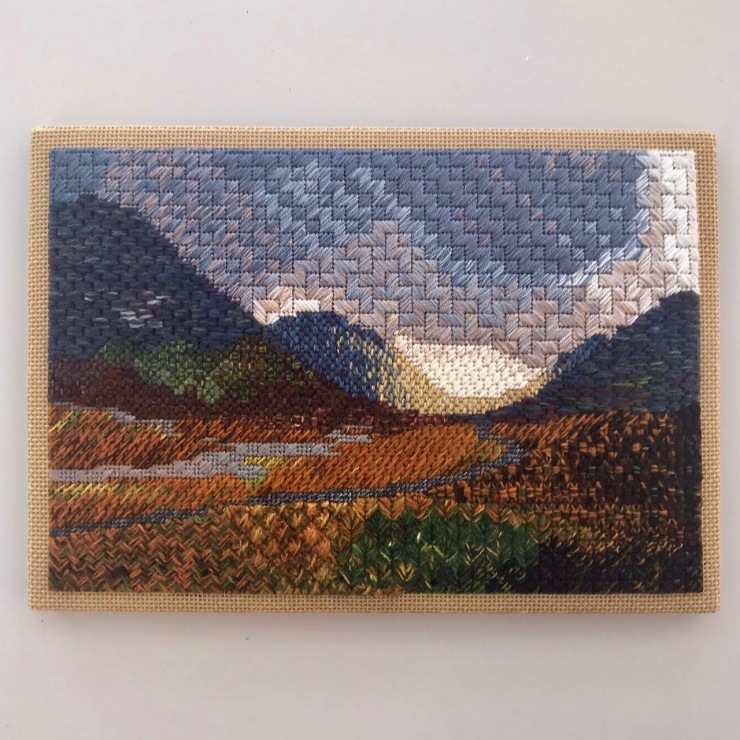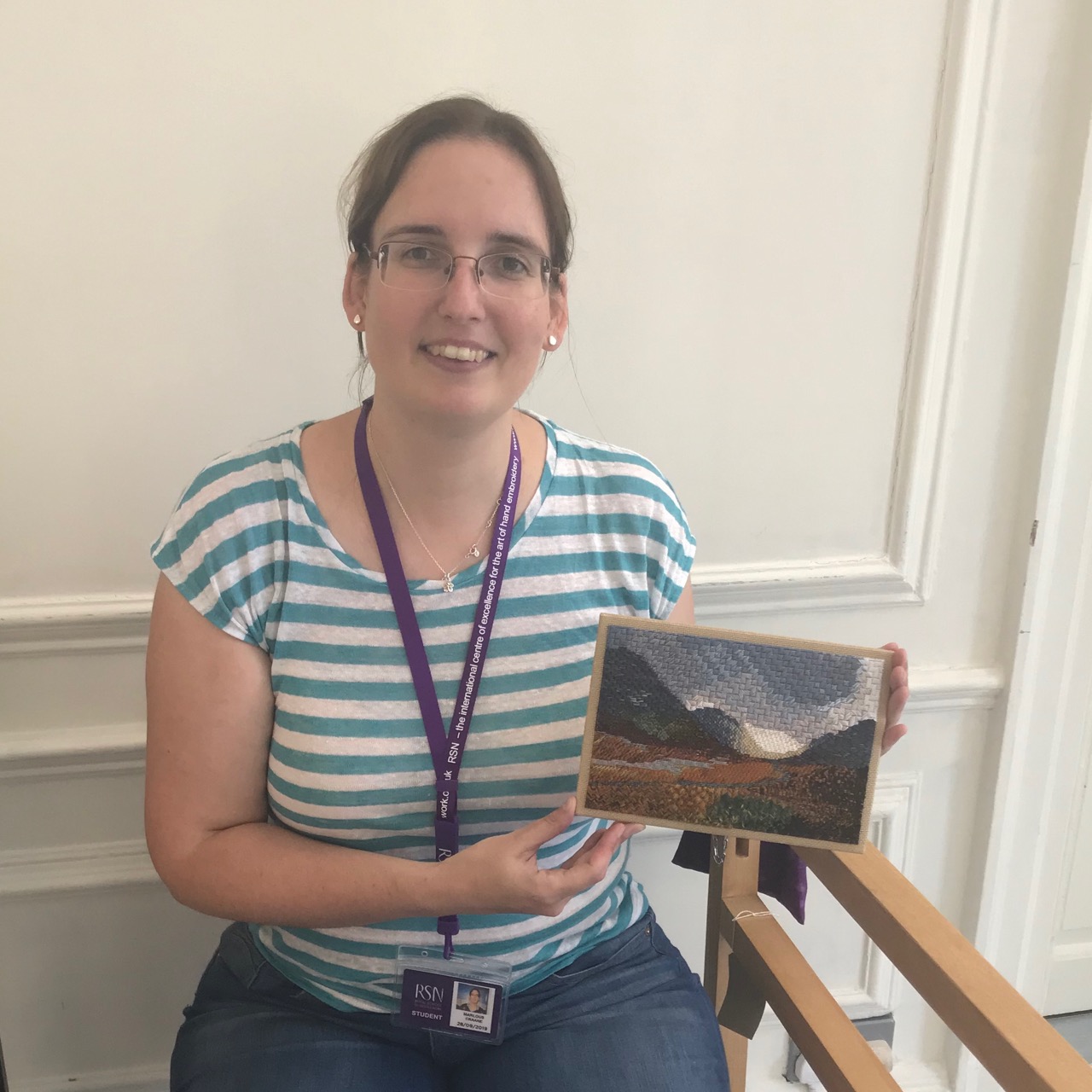Last Thursday I received the results of the assessment of my Canvaswork which I had completed as part of the Royal School of Needlework Certificate course. I contrast to the Jacobean Crewelwork module, which I completed during term time, I completed this module during as a summer intensive course.
I received 76 marks out of 88, which is about 86%. I was really happy with this mark, especially considering I completed this piece in only two weeks which hardly left any opportunity or time for unstitching or decision making, I just went with it. However, when I read through the marking I was a bit disappointed about where I lost the majority of marks.
My canvaswork is still at Hampton Court Palace as I will only pick it up when I am back at the RSN in October so unfortunately, I have not been able to take detailed pictures of the points the assessors picked up on. I have had to make do with enlargements of my original pictures. If I can find some of the faults they have picked up on once I have the actual piece in my hands I will replace the photographs with better ones.
If you like a little bit more detail about the marking process have a look at my post on the assessment of my Jacobean Crewelwork piece.
The assessment of my Canvaswork piece
In the next section of this post you will find all of the details of the assessment of my piece and my reaction to the assessor’s comments. I have put the actual comments of the assessors in italics and in quotation marks and highlighted them in pink to distinguish them from my own.
First Impressions
I scored 13 out of a possible 16 marks. The assessors found my work well presented and clean (full marks). I lost one mark on thread condition, and one mark because I had missed a couple of stitches. I also lost one more mark because two thread ends are visible from the front.
” This is a very well present piece of canvas work. Unfortunately, there are a couple of missed stitches such as within the road, within the dark brown in the bottom right and within the vegetation on the right-hand side. Overall the thread condition is very good but there is a slight amount of fluffiness within the central top area of the sky. The wool has been worked particularly well and has retained its twist. There are two thread ends which can be seen on the front from darning off, one within the blue mountain on the right and another thread from the pale grey has been brought up through the maroon section on the left. Make sure to cut these short so that they cannot be carried through from the back. Take care with the stitching at the edges of a design to ensure that the ends of the threads are hidden on the back and cannot be seen through the canvas on the front. However, you have done very well and this is minimal considering the amount of colour change within this design.”
I am amazed that they spotted the missed stitches and the loose threads. Neither my tutor or I spotted those, but that might just be because at the end of the two weeks I didn’t have a clear enough mind to spot these errors. Especially not if they are on the road, as I wouldn’t have been able to distinguish grey thread from grey paint lines. It was my first time stitching with stranded silk, so I wasn’t sure how it would behave. With only one mark lost for fluffiness, I am quite happy.
Design
I received full marks (28 out of 28) for this criterion!
“This is a lovely design for canvas work and has been adapted very well. There is a wide variety of stitches and threads throughout the design which create texture, depth and dimension.“

So happy that I decided to get my design approved at the end of my crewelwork module so I could pick out the appropriate threads before starting the summer intensive course. This gave me so many more opportunities to create a lovely design with threads to match. I would advise anyone considering doing a summer intensive in Canvaswork to do it this way as otherwise, you will only be able to use the threads the Royal School of Needlework stocks (Appletons, DMC and anchor).
Variety and use of threads and stitches
Again I scored full marks!
“You have included a large range of appropriate stitches all using the correct number of threads in the needle and the selection of thread types has been carefully chosen to replicate the textures of the original source image.“
I actually can’t believe I scored full marks for this as I didn’t think I used that many different stitches! I am really happy how my design choices worked out.
Tension and accuracy of stitches
I scored 14 out of a possible 16 marks. The assessors found that there were no lumps or bumps in my work and that I blended stitch patterns well (full marks). I lost one mark on stitch tensions, and one mark because I had miscounted at least one stitch.
” You have done very well to keep the embroidery flat, especially within the areas of denser stitching. Take care when working with different types of thread within the needle to ensure that they are all pulled with the same tension so that they lay smoothly on the surface and it is also a good idea to use a laying tool such as a mellor to help you with this. There is a miscounted stitch within the green of the straight rice but all others appear to be counted correctly. Within the sky, there is a good number of stitches blended into one another, well done.”

It is a shame you lose a complete mark for miscounting one stitch but if it is not perfect they can’t really award 4 marks, can they. I do think it is surprising considering the two weeks I had that I only miscounted once! I do agree with the stitch tension. I did find it difficult to blend different types of thread in my needle as the stitches tension is not consistent. I did use my mellor to lay the threads but I guess I just didn’t use it often enough!
Shading and overall effect
I scored 7 out of a possible 8 marks. The assessors found that there is shading throughout (full marks). I lost one mark because the assessors felt that the shading was not always appropriate at all times.
” There is a lot of shading throughout this piece. You have chosen to use saturated versions of the colours within the original source images which has worked well to create a vibrant piece, however, the russet within the central portion has become too dominant in comparison to its use within other areas. Had you blended in more of the chocolatey browns and maroons as can be seen in the surrounding areas it may have made the central portion flow a little more effectively into the horizon. The shading throughout the sky has been very well achieved, well done.”

I could hit myself for this. When stitching I felt really unsure about the orange bit in the middle thinking it was too orange. I asked my tutors and fellow students and I even posted a question on Instagram asking for feedback. However, most people agreed that it would be fine and as I completed more of the stitching around it, it started to grow on me even though I never was completely happy with it. I should have just taken out a little bit and added in more browns. Always go with your own gut instinct!
I am really happy though that they liked the shading of the sky though. I really struggled with this anyway, which was not helped because I started to run out of thread!
Mounting
It all went downhill from here. I received a total of 18 out of 24 marks for this criterion. I received full marks for the fact that my board was cut at a 90-degree angle and that the canvas was pulled taut. I lost one mark because the assessors felt that the design was not entirely centred on the front and that the corners were not entirely flat. I lost two marks on the application of the sateen and my slip stitches.
“The board has been well cut with straight edges and 90-degree corners. The design has an even rebate but the grain along the top right and bottom left runs off the edge of the board. The canvas has been pulled tight to remove all bubbles. The corners are flat and fairly neat which is difficult for canvas but needed to have had the slip stitches taken further into the points and pulled tight to pull them together. The sateen is taut however the rebate is a little inconsistent, this would have been easier had you left more of a rebate and had more room around the edges of the board. Try to fold the corners straight and when slip stitching to bring the needle out at the point to pull the sateen into a sharp corner. The slip stitching is tight in places but needed to be pulled tighter in others, try to keep the size of them consistent all the way around as this will make it easier to achieve a tighter application. Canvas is a difficult fabric to mount and this is a well-executed example.“
I felt that I did the best job possible with getting the design centred on the board. Because of the different density of stitches, it was impossible to get it taut and with an even rebate at the same time. It was either not taut or not an even rebate. I even thought that my corners were quite good considering the stiffness of the canvas. However, again if not entirely perfect, they shouldn’t award a 4. I just don’t think I would have ever have been able to get a 4, no matter how hard I tried. I was really disappointed with the marks on the sateen and slip stitches. The tutors helped me with getting the sateen taut and deciding where I should put the slip stitches. It was never mentioned that they were too close to the edge and I especially paid close attention to the even rebate as I lost a mark on that with my Jacobean Crewelwork so I just can’t imagine it was worse than my first try. I do agree a little bit on the slip stitches but you just can’t hide them as well on canvas but I didn’t think it was that bad that I had to lose two marks over it. However, it is the assessor’s job to be picky! If they were not and gave full marks for everything the RSN certificate wouldn’t be worth anything.
The assessors’ overall comment read:
“This is a very successful piece of canvas stitches, a lovely design which has been interpreted well with a carefully selected palette of threads. Well done.”
All in all, I am quite happy with the results and the comments of the assessors, especially since I completed it such a short space of time. I will pick up my piece when I am back in October and I will speak to the tutors (one of whom actually assessed my piece) about the mounting and how to improve it, as I want to get better marks when I mount my silk shading!








You did a beautiful job on this piece. Especially on that sky. It’s always interesting to read the assessment result.
LikeLiked by 1 person
Thank you Dima! I am hoping it will help others. The sky was the most difficult but very pleased with how it ended up, especially since I had to play chicken with some of the colours. It is surprising how much you need when doing canvaswork!
LikeLike
Congratulations Marlous! This is definitely a result you can be proud of. I think when you do the pieces as an intensive you need to remember that you haven’t had the chance to step back, contemplate and re-do. Which could be a benefit overall, as you have no doubt learnt a lot, and you don’t get stuck at any point in time. Thank you for sharing the comments, they are interesting and insightful as I start to think about my next canvaswork piece. It’s a shame about the mounting. Originally I was told they actually blocked the canvaswork after it was complete and took a couple of weeks to mount it to help soften the canvas. I went downhill with each piece, silk shading being the worst as I was shown a different way of doing it! No one will see it though, you have a piece you can be very proud of.
LikeLiked by 1 person
Thank you Catherine. I think it is important to remember. I would have taken more time to check it over and probable have restitched the ‘orange bit’. That is also why results of term time and intensive are not really comparable. I think either has its benefits but when you see how long some take to complete pieces (some more than a year) I think the intensive or rather the semi-intensive way is the way forward for me. Maybe the marking is stricter too with every piece?
LikeLiked by 1 person
Personally, especially after my silk shading piece, I’d take the less time approach. I don’t think the results are generally ‘worse’, and it means you do get to move forward. My results were worse as a result of not doing the intensive! I’m not sure how the marking is effected, I think in part it just depends on who marks it! Regardless, a great effort, well done!
LikeLiked by 1 person
Yes, they are there to be picky, but they’ve also said lots of nice things and picked out many successful details. Well done, indeed!
LikeLiked by 1 person
Thank you! Yes they definitely have, and it does make it easier to see things in perspective.
LikeLiked by 1 person
Wat een verhaal heb je er van gemaakt. Hier hebben andere cursisten ook wat aan.
Ik vond en vind het nog steeds een prachtig schilderij.
LikeLiked by 1 person
Dankjewel Will! Daarom schrijf ik het ook, zodat anderen er ook wat aan hebben.
LikeLike
Gorgeous job!
I’ve loved both your Jacobean & canvas projects. Can’t wait to see what you do for your silk shading one!
LikeLiked by 1 person
Thank you Stephanie! Will start my silk shading in two weeks time. Hopefully it will all go well as I think it is the most difficult technique out of the four.
LikeLike
I think you should be very proud of your work and your grade. If you think of the Royal Academy as the best if the best, it”s amazing to get in, let alone get a high B+ with those wonderful comments. Congrats! The standards are very high and you get better and better as you learn. Can’t wait for the next installment! Barb in CA
LikeLiked by 1 person
Thank you Barbara! The standards are very high, but it is sometimes difficult to see your own results in perspective as you don’t know any others. The next installment will start in two weeks time!
LikeLike
Congratulations…..good job!
LikeLiked by 1 person
Thank you!!!
LikeLike
Congratulations, I really like your piece, particularly the muted colour scheme.
LikeLiked by 1 person
Thank you so much Deborah!
LikeLiked by 1 person
Well done Marlous! While doing the RSN certificate classes via the intensive mode does get them done more quickly, it certainly is makes it much harder to get the really high marks as there simply is not time to redo anything, especially mounting. I agree that sometimes you just need to go with your gut on whether something looks right or not. You did a really great job on this. Congratulations.
LikeLiked by 1 person
Thank you so much Sally! It is a really good to hear that from someone else who has do the intensives. Have you got your marks back yet?
LikeLike
Mooie gedaan Marlous. Ook je eigen evaluatie.
LikeLiked by 1 person
Dankjewel Papa!
LikeLike